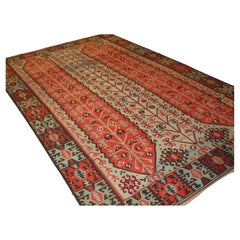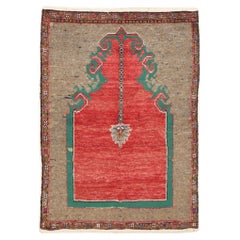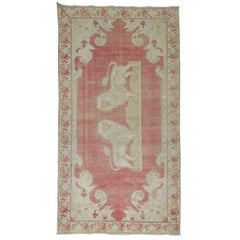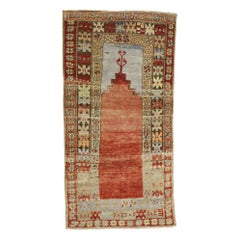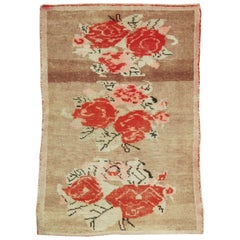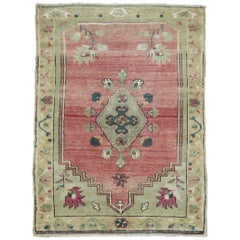Edwardian Turkish Rugs
5
to
1
4
1
5
5
5
3,229
684
408
113
83
46
44
34
26
25
24
24
12
11
11
5
2
Width
to
Length
to
5
5
5
5
5
5
Style: Edwardian
Antique Turkish Sivas Kilim of Rare Design
Located in Moreton-In-Marsh, GB
An antique Anatolian village kilim from the Sivas region of Central Eastern Turkey. The kilim has a most unusual and interesting design with a tree of life. Woven with a superb colou...
Category
20th Century Turkish Edwardian Turkish Rugs
Materials
Wool
Early 20th Century Handmade Turkish Oushak Room Size Carpet
Located in New York, NY
An antique Turkish Oushak room size carpet handmade during the early 20th century.
Measures: 10' 3" x 12' 10"
Turkish Rugs & Carpets:
Until the Great Persian Carpet Revival in the later 19th century, the “Oriental rug” was Turkish. For nearly six centuries, Turkish rugs, both scatter, room size, and even larger, thoroughly dominated the European import market. Whereas the Persian carpet can be divided into urban, village, and tribal types, in Turkey and its predecessor the Ottoman Empire, rugs almost exclusively came from village weavers and from a small number of urban workshops. Ninety percent village, nine percent city, one percent tribal.
Turkish weavers have, with very few exceptions, always worked with the symmetric (Turkish) knot. Wool foundations are standard practice among both town and village weavers. The exceptions, very finely woven 20th century and recent Herekeh silks from near Istanbul, and early 17th century Ottoman Court rugs from Bursa, constitute only a tiny part of the total. Always pricey, they appealed and still appeal to the clients who want lots of knots and perfect execution instead of individual personality.
The urban workshops have been centered around the western Turkish city of Oushak and its attendant port town of Smyrna. Oushak weaves with the trends in fashion. When color saturated medallion carpets were needed, Oushak was ready in the 17th and 18th centuries. When coarse red and blue carpets...
Category
Early 20th Century Turkish Edwardian Turkish Rugs
Materials
Wool
Zabihi Collection 20th Century Red Brown Green Turkish Anatolian Prayer Rug
Located in New York, NY
One of a kind Turkish prayer rug woven in central Turkey
Measures: 2'11" x 3'11".
Category
20th Century Turkish Edwardian Turkish Rugs
Materials
Wool
Pictorial Turkish Anatolian Rug
Located in New York, NY
Pictorial Animal Vintage Turkish Anatolian rug in soft pink and cream accents.
Category
20th Century Turkish Edwardian Turkish Rugs
Materials
Wool
Palace Size Salmon Antique Oushak Carpet
Located in New York, NY
An enormous antique Turkish Oushak rug with a very interesting turquoise shade with a caramel center medallion set on a salmon ground. In pretty good condition which is uncommon for ...
Category
Early 20th Century Turkish Edwardian Turkish Rugs
Materials
Wool
Related Items
Vintage Turkish Oushak Prayer Rug, Anatolian Prayer Rug
Located in Dallas, TX
52748 vintage Turkish Oushak Prayer rug, Anatolian Prayer rug. Immersed in Anatolian history and refined colors, this hand knotted wool vintage Turkish prayer rug combines simplicity...
Category
Mid-20th Century Turkish Edwardian Turkish Rugs
Materials
Wool
Vintage Turkish Anatolian Rug
Located in New York, NY
A vintage Turkish Anatolian rug from the mid-20th century.
Measures: 2' 2" x 3' 1"
Category
Mid-20th Century Turkish Edwardian Turkish Rugs
Materials
Wool
Vintage Turkish Anatolian Rug
Located in New York, NY
A vintage Turkish Anatolian rug from the mid-20th century.
Measures: 2' 7" x 3' 5"
Category
Mid-20th Century Turkish Edwardian Turkish Rugs
Materials
Wool
Vintage Turkish Oushak Prayer Rug, Anatolian Prayer Rug
Located in Dallas, TX
52094, vintage Turkish Oushak Prayer rug, Anatolian Prayer rug. This hand knotted wool vintage Turkish Oushak prayer rug features a stepped Mihrab prayer n...
Category
Mid-20th Century Turkish Edwardian Turkish Rugs
Materials
Wool
Vintage Turkish Anatolian Rug
Located in New York, NY
A vintage Turkish Anatolian rug from the mid-20th century.
Measures: 3' 11" x 7' 5"
Category
Mid-20th Century Turkish Edwardian Turkish Rugs
Materials
Wool
Vintage Turkish Anatolian Pictorial Rug
Located in New York, NY
A vintage Turkish Anatolian pictorial rug from the mid-20th century. A self-taught artist has depicted six buildings and one smokestack in a co...
Category
Mid-20th Century Turkish Edwardian Turkish Rugs
Materials
Wool
Vintage Turkish Anatolian Prayer Rug
Located in Dallas, TX
74863, Vintage Turkish Oushak prayer rug. This hand-knotted wool vintage Turkish Oushak prayer rug displays timeless colors blue, soft red and cream with a light yellow accent. A stylized mihrab is filled with a square and additional symbolic Turkish motifs on a blue background. The edges of the mihrab have stair step edges creating two spandrels while the bottom half of displays two bold motifs dotted with smaller stylized flowers. This Anatolian prayer rug...
Category
Mid-20th Century Turkish Edwardian Turkish Rugs
Materials
Wool
Vintage Turkish Anatolian Rug
Located in New York, NY
A vintage Turkish pictorial Anatolian carpet from the mid-20th century.
Measures: 6' 5" x 7' 7"
Category
Mid-20th Century Turkish Edwardian Turkish Rugs
Materials
Wool
Vintage Turkish Anatolian Rug
Located in New York, NY
A vintage Turkish Anatolian rug from the second half of the 20th century.
Measures: 2' 11" x 6' 2"
Category
20th Century Turkish Edwardian Turkish Rugs
Materials
Wool
Mid-20th Century Handmade Turkish Anatolian Runner
Located in New York, NY
A vintage Turkish Anatolian rug in runner format handmade during the mid-20th century.
Measures: 2' 7" x 7' 4"
Turkish rugs & carpets:
Until the Great Persian Carpet Revival in the later 19th century, the “Oriental rug” was Turkish. For nearly six centuries, Turkish rugs, both scatter, room size, and even larger, thoroughly dominated the European import market. Whereas the Persian carpet can be divided into urban, village, and tribal types, in Turkey and its predecessor the Ottoman Empire, rugs almost exclusively came from village weavers and from a small number of urban workshops. Ninety percent village, nine percent city, one percent tribal.
Turkish weavers have, with very few exceptions, always worked with the symmetric (Turkish) knot. Wool foundations are standard practice among both town and village weavers. The exceptions, very finely woven 20th century and recent Herekeh silks from near Istanbul, and early 17th century Ottoman Court rugs from Bursa, constitute only a tiny part of the total. Always pricey, they appealed and still appeal to the clients who want lots of knots and perfect execution instead of individual personality.
The urban workshops have been centered around the western Turkish city of Oushak and its attendant port town of Smyrna. Oushak weaves with the trends in fashion. When color saturated medallion carpets were needed, Oushak was ready in the 17th and 18th centuries. When coarse red and blue carpets were required, Oushak and Smyrna in the 19th century wove them by the boatload. When tastes changed again, and the European dealers in Smyrna wanted room size carpets with lighter and unusual colors, and with Persianate designs, production ramped up in nearby Oushak. Those antique, all-wool construction turn-of-the-century carpets are still in high demand with designers. Antique carpets with allover, roughly drawn patterns on grounds of shrimp, rust, straw, cream, pale blue, and pale and pea green, hitherto unavailable colors, are in such demand today that contemporary Oushaks have attempted to mimic them with soft palettes, extra-large scale drawing and coarse weaves.
Oushaks woven for the Turkish market, for palaces, houses and mosques were often oversize with large, repeating medallions, all in shades of (Turkey) red, dark blue, light blue-teal, and ivory, with lemon and green accents. Turkey, along with India, invented standard sizes. By vertically repeating the medallion, one could get one medallion, one with two end halves, two, three, etc. medallions, up to thirty or so feet in length. The process spared making new cartoons for each length and allowed a quicker turnaround time. Oushak, from the time of 15th century “Holbein” rugs onward, has always been a commercial center.
The prayer niche directional rug is primarily a Turkish development. In the towns and villages east of Oushak, in Ghiordes, Kula, Ladik, Kirsehir, Mucur and Konya, among others, arch pattern scatters with bright palettes and weaves varying from relatively fine to moderate were almost the entire production. Antique examples were particularly popular in America around 1900.
Other centers of village weaving were situated on the western coast and adjacent islands with the town of Melas and neighboring villages weaving geometric prayer rugs and scatters with a characteristic khaki green and lots of yellow.
The other large region was in the northwest of Anatolia, near ancient Troy, with the sizable town of Bergama at its center. The satellite towns of Ezine, Karakecilli, Yuntdag, and Canakkale all wove colorful scatters with moderate weaves in all wool with geometric designs and cheerful palettes. Near to Istanbul, these were among the first Turkish rugs to reach Europe in the Renaissance.
The earliest Turkish pieces depicted in Italian Old Master paintings display the so-called “Memling gul”, an allover panel pattern with hooked and stepped elements within the reserves. This pattern continues for centuries in the Konya area and in the Caucasus as well.
Turkey is a land of villages and much of the most interesting Turkish weaving comes from one undiscovered village or another. The Konya-Cappadocia region of central Turkey includes the active towns of Karapinar, Karaman, Obruk, Sizma, and Tashpinar, all weaving Konya-esque scatters and long rugs. Karapinar has been active the longest, since the 17th century. The mosques in and around Konya have preserved locally-made rugs from the fourteenth. In the 20th century, the extra-long pile, many wefted Tulu rug was devised, with limited palettes and color block patterns. These are not really antique Tulus, but they must be a product of long-standing village tradition.
There are thousands upon thousands of rural Turkish villages, almost all with easy access to local tribal wool. Rug students are discovering new names and rug types almost daily. The common denominators are bright colors, geometric designs, wool construction, moderate to coarse weaves and symmetric knots. Synthetic dyes hit the Turkish rug industry quickly and hard after 1870, and they penetrated to even the most off-the-beaten-track villages. This development was almost entirely negative. The village weavers used fugitive or overly bright dyes which ruined the color harmonies built up over centuries. Characteristic types disappeared or were negatively transmuted. The Turkish village rug of the 1870 to 1920 period is nothing to be proud of.
In the eastern provinces, the semi-nomadic Kurdish tribes, collectively called ‘Yuruks’, weave all wool, geometric pieces with medium to medium-coarse weaves, as well as kilims and other flatweaves. The rugs employ cochineal instead of madder for the reds, mustard yellows, greens, and various blues. They are under-collected like the Persian Afshars. Their rugs are in scatter and long rug formats. The far eastern Turkish town of Erzerum has a long tradition of idiosyncratic, semi-workshop rugs and further to the east is Kars with a tradition of rugs in the Caucasian Kazak manner.
One Turkish specialty is the Yastiks or cushion cover, made in pairs for the public living rooms of village houses. These are larger rugs in miniature and good ones are highly collectible. Like other Turkish rustic weavings, ones with synthetic dyes are almost totally undesirable. Only the tribal Baluch make similar cushion covers, known as pushtis or balishts, in the same small, oblong format. Yastiks always have a back, usually in plain weave, so that they can be easily stuffed.
When the Imperial Carpet Factory at Herekeh near Istanbul closed in the early 20th century, the highly proficient Armenian master weavers set up in the Kum Kapi district of Istanbul where they wove all-silk, exquisitely fine and elaborately detailed small pieces, sometimes enriched with metal thread, for the most discriminating European buyers. Today the best, signed Kum Kapi pieces, usually in the “Sultan’s head” prayer niche design, can fetch upwards of $100,000. They are strictly for the wall. An Interwar all-silk room size Kum Kapi carpet is both exceedingly rare and stratospherically priced. The workshops closed in the 1930s, but the weaving of extremely fine, all-silk small rugs in Herekeh was revived in the 1960s.
There has been a recent vogue for larger Turkish village vintage...
Category
Mid-20th Century Turkish Edwardian Turkish Rugs
Materials
Wool
Mid-20th Century Handmade Turkish Anatolian Accent Rug
Located in New York, NY
A vintage Turkish Anatolian accent rug handmade during the mid-20th century.
Measures: 3' 6" x 6' 7"
Turkish rugs & carpets:
Until the Great Persian Carpet Revival in the later 19th century, the “Oriental rug” was Turkish. For nearly six centuries, Turkish rugs, both scatter, room size, and even larger, thoroughly dominated the European import market. Whereas the Persian carpet can be divided into urban, village, and tribal types, in Turkey and its predecessor the Ottoman Empire, rugs almost exclusively came from village weavers and from a small number of urban workshops. Ninety percent village, nine percent city, one percent tribal.
Turkish weavers have, with very few exceptions, always worked with the symmetric (Turkish) knot. Wool foundations are standard practice among both town and village weavers. The exceptions, very finely woven 20th century and recent Herekeh silks from near Istanbul, and early 17th century Ottoman Court rugs from Bursa, constitute only a tiny part of the total. Always pricey, they appealed and still appeal to the clients who want lots of knots and perfect execution instead of individual personality.
The urban workshops have been centered around the western Turkish city of Oushak and its attendant port town of Smyrna. Oushak weaves with the trends in fashion. When color saturated medallion carpets were needed, Oushak was ready in the 17th and 18th centuries. When coarse red and blue carpets...
Category
Mid-20th Century Turkish Edwardian Turkish Rugs
Materials
Wool
Antique Turkish Oushak Decorative Oriental Carpet, Large Size, with Ivory Field
Located in New York, NY
A gorgeous antique Turkish Oushak carpet, circa 1900, size 15'8 x 13'1. This lovely carpet features an unusual design in the ivory central field, characterized by floral blossoms, vi...
Category
Early 1900s Turkish Antique Edwardian Turkish Rugs
Materials
Wool
Previously Available Items
Turkish Anatolian Rug
Located in New York, NY
Casual pink, green and purple highlight this vintage Turkish Anatolian rug.
Category
20th Century Turkish Edwardian Turkish Rugs
Materials
Wool
Edwardian turkish rugs for sale on 1stDibs.
Find a broad range of unique Edwardian turkish rugs for sale on 1stDibs. Many of these items were first offered in the Early 20th Century, but contemporary artisans have continued to produce works inspired by this style. If you’re looking to add vintage turkish rugs created in this style to your space, the works available on 1stDibs include rugs and carpets and other home furnishings, frequently crafted with fabric, wool and other materials. If you’re shopping for used Edwardian turkish rugs made in a specific country, there are Asia, Caucasus, and Turkey pieces for sale on 1stDibs. It’s true that these talented designers have at times inspired knockoffs, but our experienced specialists have partnered with only top vetted sellers to offer authentic pieces that come with a buyer protection guarantee. Prices for turkish rugs differ depending upon multiple factors, including designer, materials, construction methods, condition and provenance. On 1stDibs, the price for these items starts at $1,250 and tops out at $65,000 while the average work can sell for $10,512.
Recently Viewed
View AllMore Ways To Browse
Small Arched Storage Cabinet
Wardrobe Oak Carved
Oak Chairs Rush Seats
Louis Xv Serpentine Chest
Small Wood Dressers
Bedside Chests Mid Century
Management Office Chair
Shoe Cabinet
Small Desk Inlaid
Antique Collector Cabinet
French Wooden Chest
Deep Shelving
Vintage Vanity Dressing Table With Mirror
Denmark Teak Wall Unit
Danish Teak Wall Unit
Class Desk
Pair Of Rosewood Doors
Pair Decorative Console Tables
